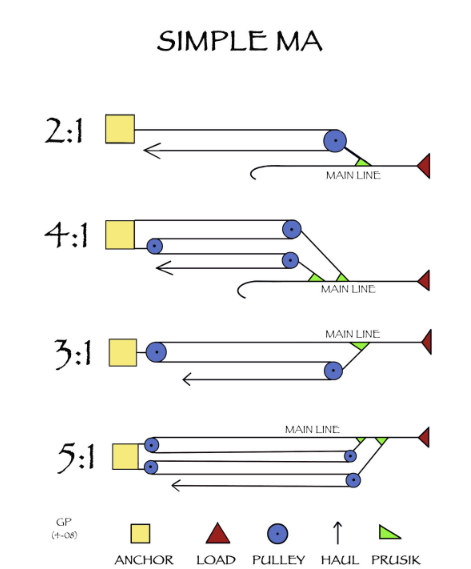Basic Mechanical Advantage Systems & Simple Pulley Setups
For many rescue scenarios, simplicity is key. Basic MA systems, like the 3:1 “Z-rig,” use straightforward pulley configurations to achieve force multiplication. The Z-rig setup resembles a “Z” shape and can effectively reduce the amount of effort needed to lift a load. For instance, applying 100 pounds of force in a 3:1 Z-rig system theoretically enables the lifting of a 300-pound load. However, it’s important to note that real-world friction from pulleys and ropes will slightly reduce the effective mechanical advantage.
Key Components of Basic MA Systems
- Single Pulleys: These are fundamental in MA systems as they redirect the force applied by rescuers, making it easier to lift or move a load. Though they don’t add mechanical advantage on their own, pulleys are essential in creating an effective force path.
- Anchors: Strong and stable attachment points, anchors are the foundation of any MA system. Whether it’s a fixed object like a tree or a reinforced vehicle hitch, the anchor must be bombproof to handle the entire system’s force safely.
- Rope: The rope is the lifeline that connects the load to the pulling force. In a basic system, the rope’s strength and condition are critical as it bears the weight of the load and any forces applied during lifting or lowering.
Advantages of Basic MA Systems
- Simplicity: Basic MA systems are easy to set up and understand, making them ideal for teams needing quick deployment with minimal gear and instruction. This simplicity reduces the potential for errors, which is crucial in high-stress situations.
- Efficiency: Basic systems provide a manageable boost in mechanical advantage without introducing excessive complexity. They are suitable for operations where minimal mechanical advantage suffices, such as lifting lighter loads or making minor adjustments.
Practical Applications of Basic MA Systems
Basic MA systems are valuable in situations requiring rapid response and manageable loads. Here are a few common scenarios:
- Lifting Light to Moderate Loads: For operations involving manageable weights, like equipment retrieval or minor patient lifts, basic setups provide sufficient lifting power with minimal setup time.
- Quick Deployment in Emergencies: In critical rescue scenarios where every second counts, a simple MA system like a 3:1 Z-rig can be quickly assembled and deployed to achieve immediate results. This is especially beneficial for smaller teams or solo rescuers who need to act fast with limited equipment.
Basic mechanical advantage systems provide an accessible entry point into the world of rescue rigging. Their simplicity and efficiency make them indispensable tools for rescue teams, enabling safe and effective load management in various situations. Whether lifting equipment, adjusting patient positioning, or performing swift evacuations, these simple pulley setups ensure that rescuers can work with confidence and control.
Stay tuned for the next part of our series, where we’ll delve into more complex MA systems, exploring compound setups that achieve higher mechanical advantages for handling challenging rescues.
Mastering Rigging Fundamentals: Forces, Mechanical Advantage, and Moving Systems
Peace on your Days
Lance










